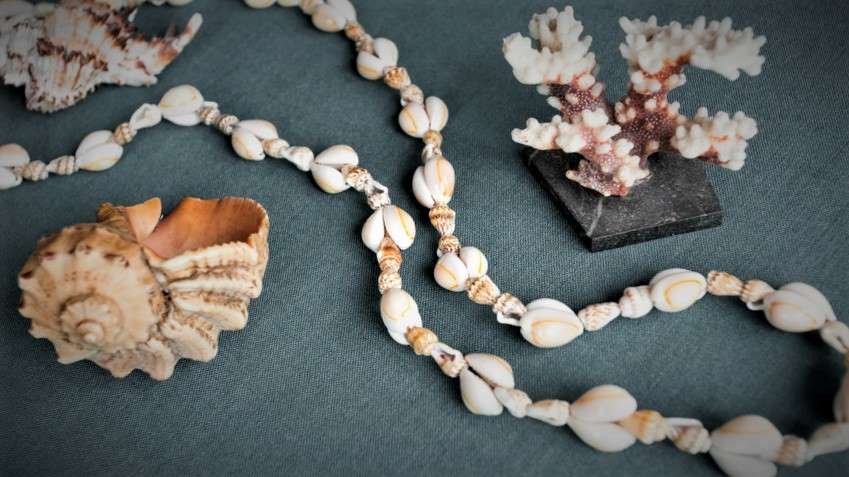Niihau Island Lei Material: Pupu shell necklace
Niihau Island is known for its iconic lei material. The official material used is a pupu shell necklace, which comes in various colors, including white, pink, tans, peach tones, brown, yellow, speckled, red, and pink. The various types of shells used in these necklaces are Kahelelani, Momiokai, Lenalena, Onikiniki, Laiki, Uliuli, and Kahakaha. The different styles of leis made from these shells are Tutu, Kanelii, Poepoe, Poleholeho, Hale, Pololei, and Pikake (Sources: [1], [2], [3])
Niihau Shells Overview
Niihau Shells are highly prized for their rarity and beauty. The only shells eligible to be called Niihau shells are those collected on the Forbidden Island of Niihau. Four main types of shells are available: kahelelani, momi, laiki, and kamoa.
Artisans have also given the shells unique descriptive terms such as ke’oke’o, ‘akala, lenalena, ‘oma’oma’o, ‘ahiehie, ikaika, kahakaha, ‘onikiniki, ‘apu’upu’u, and waha’ ula’ula.
Some shells have colorful English translations like “butterscotch” and “hot pink.” The value of these shells is impacted by availability, with rare colors commanding higher prices. To give perspective on size, Niihau Shells are often displayed next to a Hawaiian quarter minted in 2008 to display their comparative size (Source: [4]).
What are Pupu Shells?
Pupu shells are a special kind of shell used to make Niihau lei, a traditional necklace from the Hawaiian island of Niihau. These shells are some of the most eye-catching you’ll ever find, with white, pink, and yellow hues. Collecting them from the ocean floor, you’ll often find them gathered in clusters. After the shells have been retrieved, they are cleaned and strung together to make the necklace. But their beauty isn’t limited to lei – pupu shells can make many items, like rings, earrings, and hairpieces.
How do people pick shells for Niihau Shells for Lei Necklace?
Imagine spending the whole day collecting shells, only finding six highly prized dark-blue momi shells, with a handful of other shells. You pack your shells in your backpack and bicycle back home for dinner and spend time with your family before bed.
This description is the life of shell collecting in Niihau. It’s a time-consuming activity and a long process to produce beautiful shell leis that represent the unique Niihau culture. The island is off-limits to anyone who isn’t a resident or relative, a US Navy contractor on a job or invited by residents. The island doesn’t have paved roads, and transportation to and from the island is via helicopter and on the island with a bicycle.
A day in the life of a shell collector and artisan
Here is what a hypothetical day in the life of a shell collector and shell artisan may look like.
Before beginning their journey, the artisan will want to pray to God for a successful journey and that they have packed a backpack with all necessary supplies such as lunch, zip lock bags, and bottles.
The artisan will then travel to one of Niihau’s many beautiful beaches, such as Taununui, Pahuhau, Waiapalo, Tahio, Ohia, Puketua, or Putaiti, as this is the best time of year to collect shells.
Once there, they will look for dark-blue momi shells and other valuable shells. They will gather and sort according to kind, color, and size. Enjoying the Hawaiian monk seal and ulili birds accompanying them on their journey, they will pick shells from sunrise to sundown.
When they return home, they will begin the cleaning and sorting process. They will rinse the shells in salt water, scrub and clean them with a brush and a little soap, and separate them into piles of the same size, shape, and color.
Next, they will thread a needle with a natural sinnet and string the shells onto the line, tying the string off at the end. Finally, they will be able to look at their beautiful finished product and take time to admire their hard work (Source: [5])
How to select a Niihau shell lei
Selecting the perfect Ni’ihau shell lei requires careful consideration, and you should coordinate the colors to achieve either a monochromatic or mixed-style lei. The shells should have a brilliant luster, with no holes, chips, cracks, or other damage aside from the piercing by the lei maker. Uniformity in size is essential, with smaller shells being especially valued. Quality workmanship should be a priority – piercing should be consistent, knots should be tight, cowries should be flawless, and you should match the kaunoo and puka shells for size and color (Source: [6])
Sources:
- Hawaii.gov
- Hawaiianleigreetings.com
- Huapala.org
- Niihauheritage.org
- Niihauheritage.org
- Niʻihau Shell Leis by Linda Paik Moriarty, 1986, the University of Hawaii Press.

